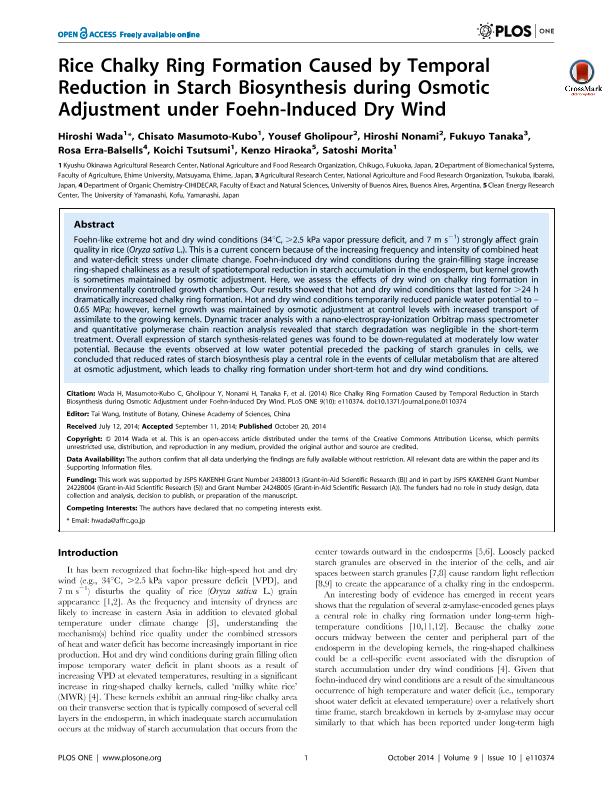Artículo
Turgor-responsive starch phosphorylation in Oryza sativa stems: A primary event of starch degradation associated with grain-filling ability
Wada, Hiroshi; Masumoto Kubo, Chisato; Tsutsumi, Koichi; Nonami, Hiroshi; Tanaka, Fukuyo; Okada, Haruka; Erra Balsells, Rosa ; Hiraoka, Kenzo; Nakashima, Taiken; Hakata, Makoto; Morita, Satoshi
; Hiraoka, Kenzo; Nakashima, Taiken; Hakata, Makoto; Morita, Satoshi
 ; Hiraoka, Kenzo; Nakashima, Taiken; Hakata, Makoto; Morita, Satoshi
; Hiraoka, Kenzo; Nakashima, Taiken; Hakata, Makoto; Morita, Satoshi
Fecha de publicación:
07/2017
Editorial:
Public Library of Science
Revista:
Plos One
ISSN:
1932-6203
Idioma:
Inglés
Tipo de recurso:
Artículo publicado
Clasificación temática:
Resumen
Grain filling ability is mainly affected by the translocation of carbohydrates generated from temporarily stored stem starch in most field crops including rice (Oryza sativa L.). The partitioning of non-structural stem carbohydrates has been recognized as an important trait for raising the yield ceiling, yet we still do not fully understand how carbohydrate partitioning occurs in the stems. In this study, two rice subspecies that exhibit different patterns of nonstructural stem carbohydrates partitioning, a japonica-dominant cultivar, Momiroman, and an indica-dominant cultivar, Hokuriku 193, were used as the model system to study the relationship between turgor pressure and metabolic regulation of non-structural stem carbohydrates, by combining the water status measurement with gene expression analysis and a dynamic prefixed 13C tracer analysis using a mass spectrometer. Here, we report a clear varietal difference in turgor-associated starch phosphorylation occurred at the initiation of non-structural carbohydrate partitioning. The data indicated that starch degradation in Hokuriku 193 stems occurred at full-heading, 5 days earlier than in Momiroman, contributing to greater sink filling. Gene expression analysis revealed that expression pattern of the gene encoding α-glucan, water dikinase (GWD1) was similar between two varieties, and the maximum expression level in Hokuriku 193, reached at full heading (4 DAH), was greater than in Momiroman, leading to an earlier increase in a series of amylase-related gene expression in Hokuriku 193. In both varieties, peaks in turgor pressure preceded the increases in GWD1 expression, and changes in GWD1 expression was correlated with turgor pressure. Additionally, a threshold is likely to exist for GWD1 expression to facilitate starch degradation. Taken together, these results raise the possibility that turgor-associated starch phosphorylation in cells is responsible for the metabolism that leads to starch degradation. Because the two cultivars exhibited remarkable varietal differences in the pattern of non-structural carbohydrate partitioning, our findings propose that the observed difference in grain-filling ability originated from turgor-associated regulation of starch phosphorylation in stem parenchyma cells. Further understanding of the molecular mechanism of turgor-regulation may provide a new selection criterion for breaking the yield barriers in crop production.
Palabras clave:
Rice
,
Stress
,
Carbohydrates
,
Ms
Archivos asociados
Licencia
Identificadores
Colecciones
Articulos(CIHIDECAR)
Articulos de CENTRO DE INVESTIGACIONES EN HIDRATOS DE CARBONO
Articulos de CENTRO DE INVESTIGACIONES EN HIDRATOS DE CARBONO
Citación
Wada, Hiroshi; Masumoto Kubo, Chisato; Tsutsumi, Koichi; Nonami, Hiroshi; Tanaka, Fukuyo; et al.; Turgor-responsive starch phosphorylation in Oryza sativa stems: A primary event of starch degradation associated with grain-filling ability; Public Library of Science; Plos One; 12; 7; 7-2017; 1-12
Compartir
Altmétricas



